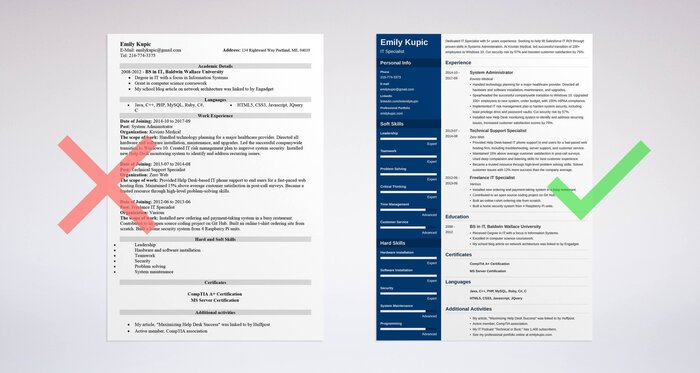Tips to Write a Perfect Technical Writer Resume
 Elmirain Technical Writing on 7/13/2022 — 5 minute read
Elmirain Technical Writing on 7/13/2022 — 5 minute read Elmirain Technical Writing on 7/13/2022 — 5 minute read
Elmirain Technical Writing on 7/13/2022 — 5 minute read

When applying for a job, you need to submit a CV (curriculum vitae) with your personal details, education, qualifications, and work history. Most jobs are advertised online, and before you submit your CV, you should study the job description carefully. It is important to find exactly what the employer is looking for (a certain amount of experience, knowledge of specific programming languages, etc.). In resumes, applicants try to show that they have all the qualities, qualifications, and experience the employer is looking for. However, not all CVs work. Some end up in the litter bin the moment the HR person sees them. This blog will focus on how to write an effective technical writer’s resume.
First, let us pin the technical writer job on the professions map. The labor market is full of jobs bordering on writing (or content creation) and technical areas, such as IT and engineering. Writing is also merging with communications, both business and political (marketing, advertising, public affairs, PR, GR, etc.).
These two tendencies have caused the emergence of new professions, such as:
This ‘triad’ forms lots of opportunities for creative people to produce high-quality textual content and, at the same time, are familiar with the daily routine of IT specialists, engineers, marketers, or government officials.
Now, let’s have a closer look at the job of a technical writer. This person lives in a world related to the technical field, which is quite wide and encompasses areas from software development to yacht design.
The main technical writer’s responsibility is to write effective technical documents (clear and concise for the target audience).
In a sense, a technical writer’s job is to translate technical content produced by technical specialists (full of tech terms and descriptions of complex phenomena) into a simple language for customers who just want to use the product.
The need for the technical writing profession has emerged due to the transformation of the way people consume information: users no longer have time to read bulky manuals. Instead, they want to perceive information intuitively or (if the product is complex) to read short and simple texts that provide quick solutions.
For example, people who want to use an electric heater at home do not necessarily need to understand the principles of its work. This is when the tech writer comes in. Their job is to write a short instruction about turning the heater on and off and switching between the heating modes. The customer does not want to know how the electric current is converted to heat. The happy owner of the heater usually has no idea of the electrical resistor inside the heater or the principle of Joule heating. The customer wants to warm the room.
The technical writer’s job is to walk in the user’s shoes and explain simple things in simple words.

Every applicant wants to get a response from potential employers. However, not all CVs pave the road to job interviews and further offers. Here are a few tips for writing an effective technical writer resume:
For more tech writer skills that can be mentioned in your CV, read our article 11 Skills of a Good Technical Writer.

It’s hard to understand the difference between good and bad CVs without examples. So, let’s give two of them.

The resume on the left is poorly structured. On the other hand, the one on the right (marked with a green tick) is more ‘to the point’ as it starts with a concise intro and work experience. The ‘Experience’ section is in the page’s center. As a result, it catches the eye of the reader immediately.
Personal info is shifted to the left and does not ‘press’ on the reader. If HR gets interested in the work experience, they will switch to personal details. By comparison, in the CV on the left (marked with a red cross), all sections are placed vertically, one over another. This makes the text lengthy and tedious.
Although a CV has a very rigid format (a certain number of sections must be fitted in), there is still some place for visualization. The resume example on the right represents skills with ‘progress bars’ showing the applicant’s level in this or that field, while on the left, we can see a list of skills only.
There are many industries where a technical writer can find a well-paid job. You can find a job in civic and social organizations. The skills of a technical writer are needed here to enhance communications with the public. For example, explanations (guides, instructions) may be required for those who want to vote online or apply to an educational institution. The electric power industry (including generation, transmission, and distribution) provides many opportunities for technical writers. Whenever a power billing and metering device is installed, the users need an instruction. Software development is another huge industry where tech writers are required, and the demand for this job is growing daily.
The efficiency of a technical writer’s resume depends on how focused you make it. Think of your audience and its needs. Give your potential employer the information they want and remove unnecessary details. Try to look at your CV with the eyes of the HR who will receive it. Show that you possess the main skill of a great tech writer – the ability to walk in your reader’s shoes.
Good luck with your technical writing!
ClickHelp Team
Author, host and deliver documentation across platforms and devices
Get monthly digest on technical writing, UX and web design, overviews of useful free resources and much more.
"*" indicates required fields